Comprehensive CQI Plan for a GP Service in Residential Aged Care
VerifiedAdded on 2020/03/04
|21
|5855
|94
Report
AI Summary
This report presents a comprehensive Continuous Quality Improvement (CQI) plan for establishing a General Practitioner (GP) service in a residential aged care facility. It emphasizes the importance of integrating risk management and quality improvement strategies to enhance healthcare for the elderly, a frequently underserved demographic. The report outlines the need for a robust business plan, discusses the critical role of leadership commitment, and details the necessary resources for a successful healthcare venture. It delves into the nuances of providing GP services in a residential setting, focusing on quality improvement frameworks, risk management parameters (including detection, estimation, evaluation, and action), and potential barriers to implementation. Furthermore, the report highlights the significance of customer focus, employee empowerment, and stakeholder involvement in achieving optimal outcomes. It also explores statistical tools and assessment techniques, alongside a realistic budget plan, concluding with actionable insights for improving the quality of care and patient outcomes in aged care facilities.
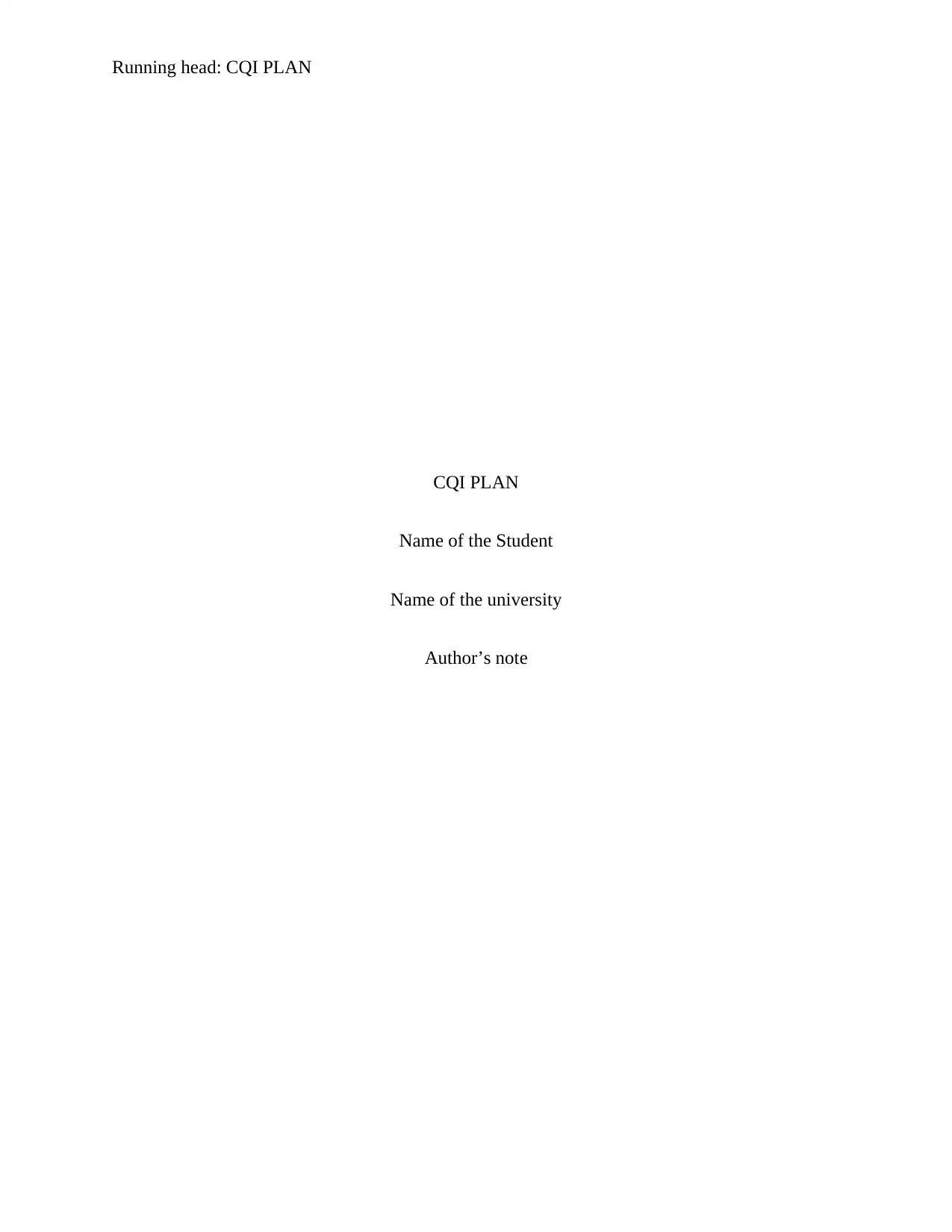
Running head: CQI PLAN
CQI PLAN
Name of the Student
Name of the university
Author’s note
CQI PLAN
Name of the Student
Name of the university
Author’s note
Paraphrase This Document
Need a fresh take? Get an instant paraphrase of this document with our AI Paraphraser
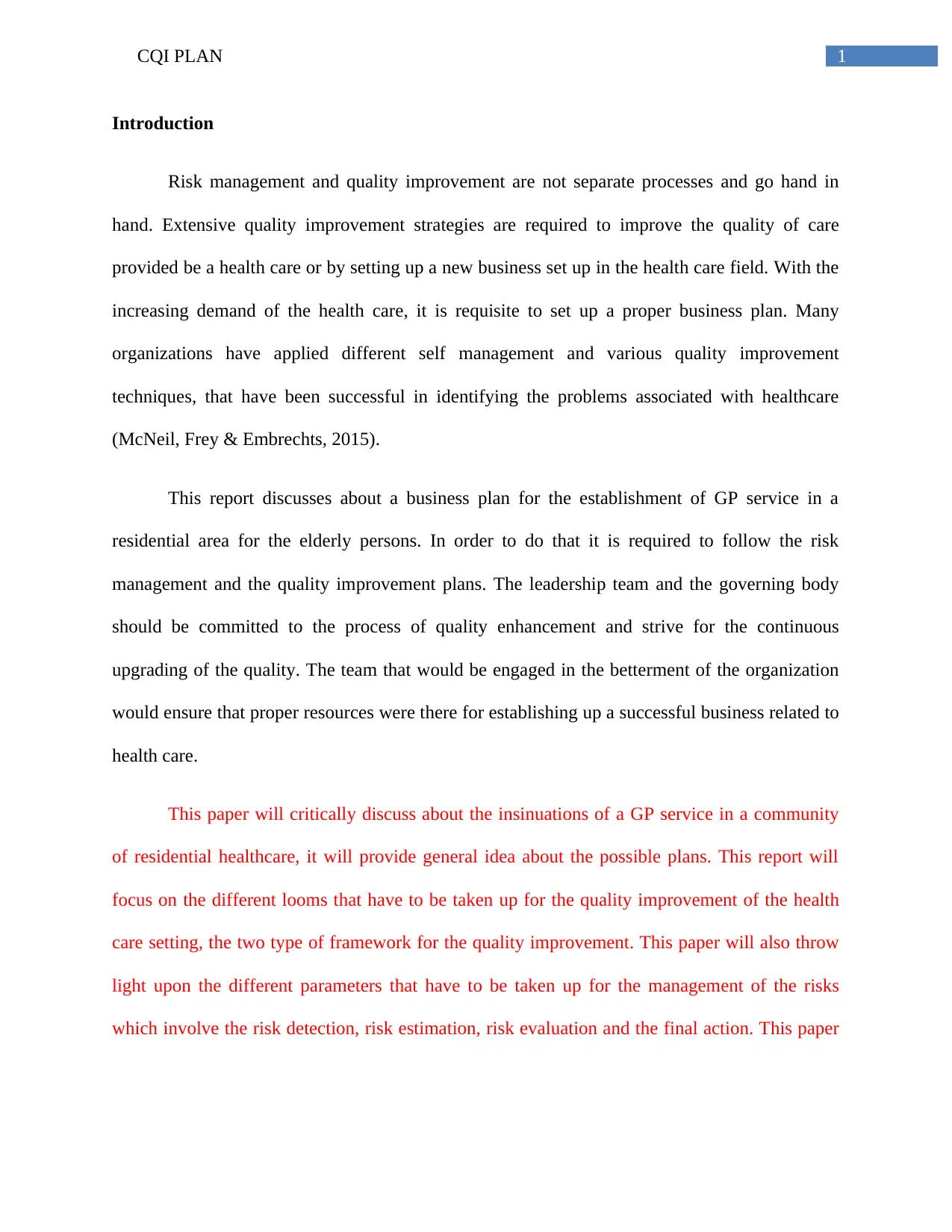
1CQI PLAN
Introduction
Risk management and quality improvement are not separate processes and go hand in
hand. Extensive quality improvement strategies are required to improve the quality of care
provided be a health care or by setting up a new business set up in the health care field. With the
increasing demand of the health care, it is requisite to set up a proper business plan. Many
organizations have applied different self management and various quality improvement
techniques, that have been successful in identifying the problems associated with healthcare
(McNeil, Frey & Embrechts, 2015).
This report discusses about a business plan for the establishment of GP service in a
residential area for the elderly persons. In order to do that it is required to follow the risk
management and the quality improvement plans. The leadership team and the governing body
should be committed to the process of quality enhancement and strive for the continuous
upgrading of the quality. The team that would be engaged in the betterment of the organization
would ensure that proper resources were there for establishing up a successful business related to
health care.
This paper will critically discuss about the insinuations of a GP service in a community
of residential healthcare, it will provide general idea about the possible plans. This report will
focus on the different looms that have to be taken up for the quality improvement of the health
care setting, the two type of framework for the quality improvement. This paper will also throw
light upon the different parameters that have to be taken up for the management of the risks
which involve the risk detection, risk estimation, risk evaluation and the final action. This paper
Introduction
Risk management and quality improvement are not separate processes and go hand in
hand. Extensive quality improvement strategies are required to improve the quality of care
provided be a health care or by setting up a new business set up in the health care field. With the
increasing demand of the health care, it is requisite to set up a proper business plan. Many
organizations have applied different self management and various quality improvement
techniques, that have been successful in identifying the problems associated with healthcare
(McNeil, Frey & Embrechts, 2015).
This report discusses about a business plan for the establishment of GP service in a
residential area for the elderly persons. In order to do that it is required to follow the risk
management and the quality improvement plans. The leadership team and the governing body
should be committed to the process of quality enhancement and strive for the continuous
upgrading of the quality. The team that would be engaged in the betterment of the organization
would ensure that proper resources were there for establishing up a successful business related to
health care.
This paper will critically discuss about the insinuations of a GP service in a community
of residential healthcare, it will provide general idea about the possible plans. This report will
focus on the different looms that have to be taken up for the quality improvement of the health
care setting, the two type of framework for the quality improvement. This paper will also throw
light upon the different parameters that have to be taken up for the management of the risks
which involve the risk detection, risk estimation, risk evaluation and the final action. This paper
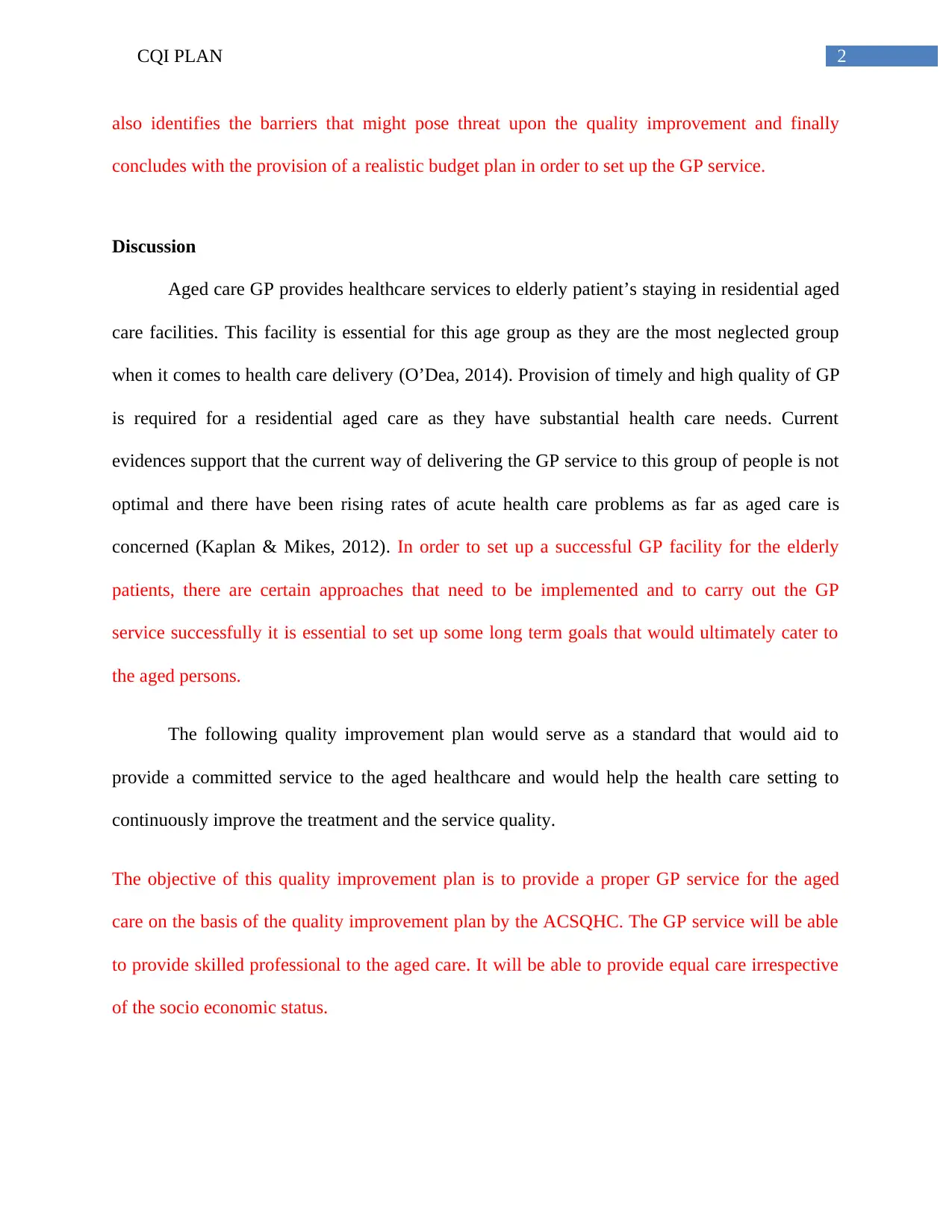
2CQI PLAN
also identifies the barriers that might pose threat upon the quality improvement and finally
concludes with the provision of a realistic budget plan in order to set up the GP service.
Discussion
Aged care GP provides healthcare services to elderly patient’s staying in residential aged
care facilities. This facility is essential for this age group as they are the most neglected group
when it comes to health care delivery (O’Dea, 2014). Provision of timely and high quality of GP
is required for a residential aged care as they have substantial health care needs. Current
evidences support that the current way of delivering the GP service to this group of people is not
optimal and there have been rising rates of acute health care problems as far as aged care is
concerned (Kaplan & Mikes, 2012). In order to set up a successful GP facility for the elderly
patients, there are certain approaches that need to be implemented and to carry out the GP
service successfully it is essential to set up some long term goals that would ultimately cater to
the aged persons.
The following quality improvement plan would serve as a standard that would aid to
provide a committed service to the aged healthcare and would help the health care setting to
continuously improve the treatment and the service quality.
The objective of this quality improvement plan is to provide a proper GP service for the aged
care on the basis of the quality improvement plan by the ACSQHC. The GP service will be able
to provide skilled professional to the aged care. It will be able to provide equal care irrespective
of the socio economic status.
also identifies the barriers that might pose threat upon the quality improvement and finally
concludes with the provision of a realistic budget plan in order to set up the GP service.
Discussion
Aged care GP provides healthcare services to elderly patient’s staying in residential aged
care facilities. This facility is essential for this age group as they are the most neglected group
when it comes to health care delivery (O’Dea, 2014). Provision of timely and high quality of GP
is required for a residential aged care as they have substantial health care needs. Current
evidences support that the current way of delivering the GP service to this group of people is not
optimal and there have been rising rates of acute health care problems as far as aged care is
concerned (Kaplan & Mikes, 2012). In order to set up a successful GP facility for the elderly
patients, there are certain approaches that need to be implemented and to carry out the GP
service successfully it is essential to set up some long term goals that would ultimately cater to
the aged persons.
The following quality improvement plan would serve as a standard that would aid to
provide a committed service to the aged healthcare and would help the health care setting to
continuously improve the treatment and the service quality.
The objective of this quality improvement plan is to provide a proper GP service for the aged
care on the basis of the quality improvement plan by the ACSQHC. The GP service will be able
to provide skilled professional to the aged care. It will be able to provide equal care irrespective
of the socio economic status.
⊘ This is a preview!⊘
Do you want full access?
Subscribe today to unlock all pages.

Trusted by 1+ million students worldwide
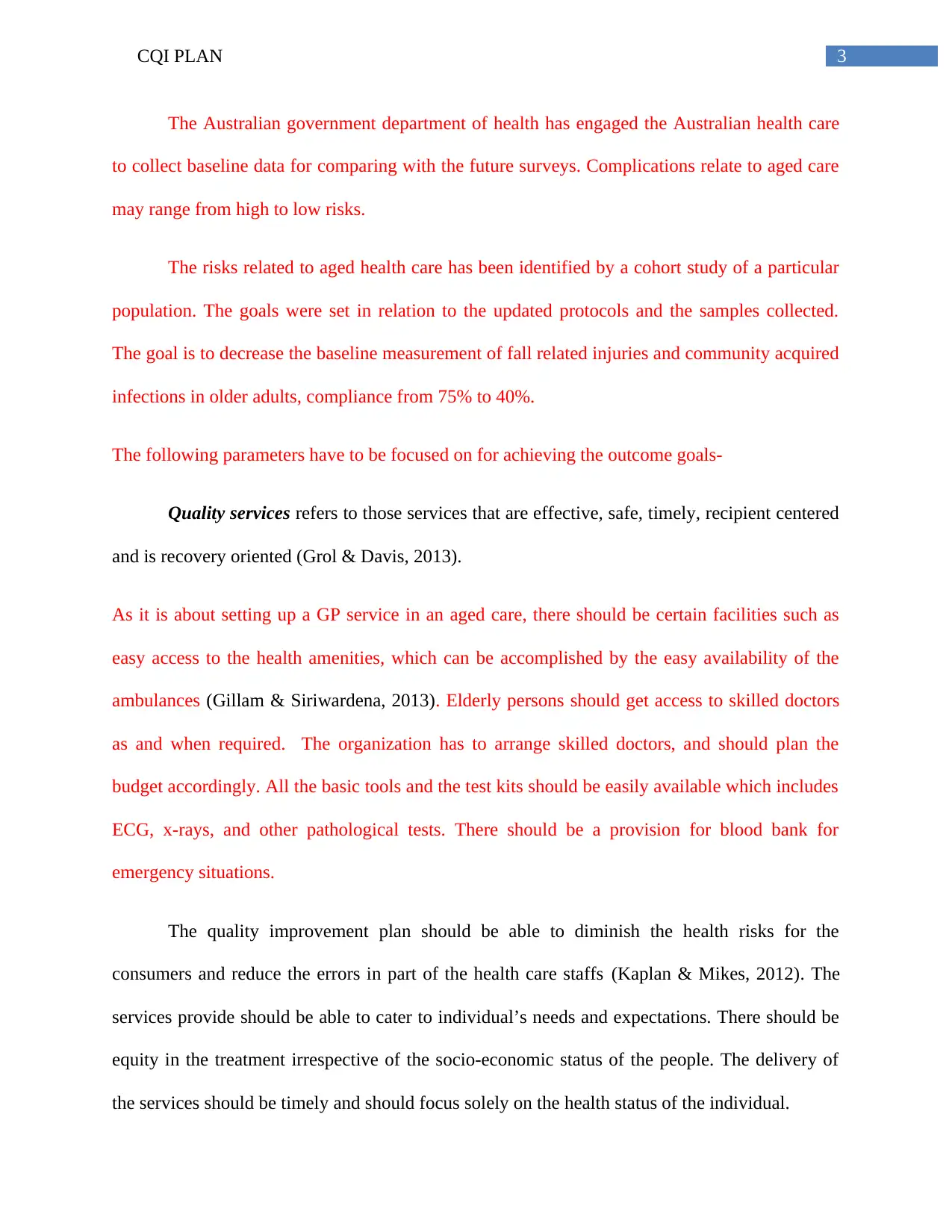
3CQI PLAN
The Australian government department of health has engaged the Australian health care
to collect baseline data for comparing with the future surveys. Complications relate to aged care
may range from high to low risks.
The risks related to aged health care has been identified by a cohort study of a particular
population. The goals were set in relation to the updated protocols and the samples collected.
The goal is to decrease the baseline measurement of fall related injuries and community acquired
infections in older adults, compliance from 75% to 40%.
The following parameters have to be focused on for achieving the outcome goals-
Quality services refers to those services that are effective, safe, timely, recipient centered
and is recovery oriented (Grol & Davis, 2013).
As it is about setting up a GP service in an aged care, there should be certain facilities such as
easy access to the health amenities, which can be accomplished by the easy availability of the
ambulances (Gillam & Siriwardena, 2013). Elderly persons should get access to skilled doctors
as and when required. The organization has to arrange skilled doctors, and should plan the
budget accordingly. All the basic tools and the test kits should be easily available which includes
ECG, x-rays, and other pathological tests. There should be a provision for blood bank for
emergency situations.
The quality improvement plan should be able to diminish the health risks for the
consumers and reduce the errors in part of the health care staffs (Kaplan & Mikes, 2012). The
services provide should be able to cater to individual’s needs and expectations. There should be
equity in the treatment irrespective of the socio-economic status of the people. The delivery of
the services should be timely and should focus solely on the health status of the individual.
The Australian government department of health has engaged the Australian health care
to collect baseline data for comparing with the future surveys. Complications relate to aged care
may range from high to low risks.
The risks related to aged health care has been identified by a cohort study of a particular
population. The goals were set in relation to the updated protocols and the samples collected.
The goal is to decrease the baseline measurement of fall related injuries and community acquired
infections in older adults, compliance from 75% to 40%.
The following parameters have to be focused on for achieving the outcome goals-
Quality services refers to those services that are effective, safe, timely, recipient centered
and is recovery oriented (Grol & Davis, 2013).
As it is about setting up a GP service in an aged care, there should be certain facilities such as
easy access to the health amenities, which can be accomplished by the easy availability of the
ambulances (Gillam & Siriwardena, 2013). Elderly persons should get access to skilled doctors
as and when required. The organization has to arrange skilled doctors, and should plan the
budget accordingly. All the basic tools and the test kits should be easily available which includes
ECG, x-rays, and other pathological tests. There should be a provision for blood bank for
emergency situations.
The quality improvement plan should be able to diminish the health risks for the
consumers and reduce the errors in part of the health care staffs (Kaplan & Mikes, 2012). The
services provide should be able to cater to individual’s needs and expectations. There should be
equity in the treatment irrespective of the socio-economic status of the people. The delivery of
the services should be timely and should focus solely on the health status of the individual.
Paraphrase This Document
Need a fresh take? Get an instant paraphrase of this document with our AI Paraphraser
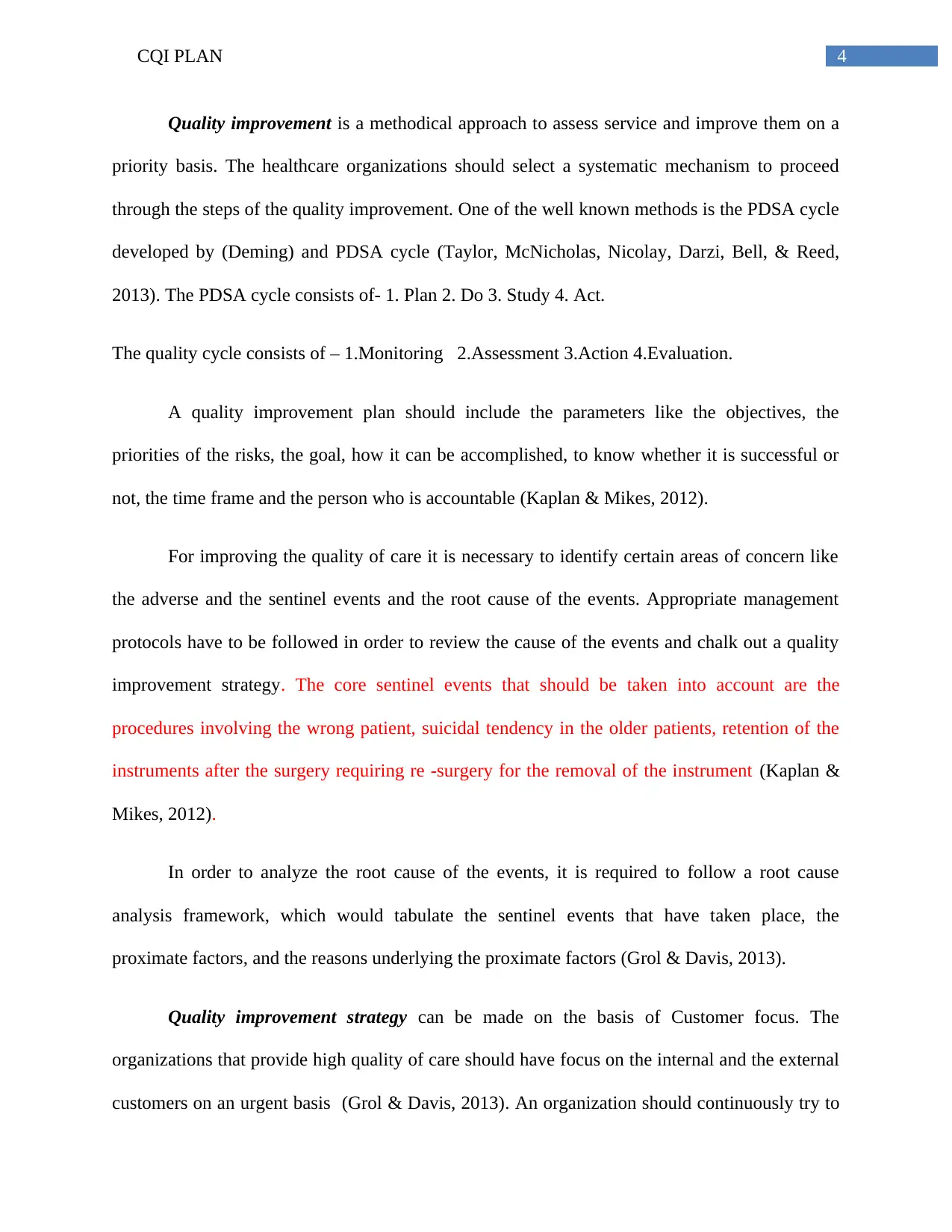
4CQI PLAN
Quality improvement is a methodical approach to assess service and improve them on a
priority basis. The healthcare organizations should select a systematic mechanism to proceed
through the steps of the quality improvement. One of the well known methods is the PDSA cycle
developed by (Deming) and PDSA cycle (Taylor, McNicholas, Nicolay, Darzi, Bell, & Reed,
2013). The PDSA cycle consists of- 1. Plan 2. Do 3. Study 4. Act.
The quality cycle consists of – 1.Monitoring 2.Assessment 3.Action 4.Evaluation.
A quality improvement plan should include the parameters like the objectives, the
priorities of the risks, the goal, how it can be accomplished, to know whether it is successful or
not, the time frame and the person who is accountable (Kaplan & Mikes, 2012).
For improving the quality of care it is necessary to identify certain areas of concern like
the adverse and the sentinel events and the root cause of the events. Appropriate management
protocols have to be followed in order to review the cause of the events and chalk out a quality
improvement strategy. The core sentinel events that should be taken into account are the
procedures involving the wrong patient, suicidal tendency in the older patients, retention of the
instruments after the surgery requiring re -surgery for the removal of the instrument (Kaplan &
Mikes, 2012).
In order to analyze the root cause of the events, it is required to follow a root cause
analysis framework, which would tabulate the sentinel events that have taken place, the
proximate factors, and the reasons underlying the proximate factors (Grol & Davis, 2013).
Quality improvement strategy can be made on the basis of Customer focus. The
organizations that provide high quality of care should have focus on the internal and the external
customers on an urgent basis (Grol & Davis, 2013). An organization should continuously try to
Quality improvement is a methodical approach to assess service and improve them on a
priority basis. The healthcare organizations should select a systematic mechanism to proceed
through the steps of the quality improvement. One of the well known methods is the PDSA cycle
developed by (Deming) and PDSA cycle (Taylor, McNicholas, Nicolay, Darzi, Bell, & Reed,
2013). The PDSA cycle consists of- 1. Plan 2. Do 3. Study 4. Act.
The quality cycle consists of – 1.Monitoring 2.Assessment 3.Action 4.Evaluation.
A quality improvement plan should include the parameters like the objectives, the
priorities of the risks, the goal, how it can be accomplished, to know whether it is successful or
not, the time frame and the person who is accountable (Kaplan & Mikes, 2012).
For improving the quality of care it is necessary to identify certain areas of concern like
the adverse and the sentinel events and the root cause of the events. Appropriate management
protocols have to be followed in order to review the cause of the events and chalk out a quality
improvement strategy. The core sentinel events that should be taken into account are the
procedures involving the wrong patient, suicidal tendency in the older patients, retention of the
instruments after the surgery requiring re -surgery for the removal of the instrument (Kaplan &
Mikes, 2012).
In order to analyze the root cause of the events, it is required to follow a root cause
analysis framework, which would tabulate the sentinel events that have taken place, the
proximate factors, and the reasons underlying the proximate factors (Grol & Davis, 2013).
Quality improvement strategy can be made on the basis of Customer focus. The
organizations that provide high quality of care should have focus on the internal and the external
customers on an urgent basis (Grol & Davis, 2013). An organization should continuously try to
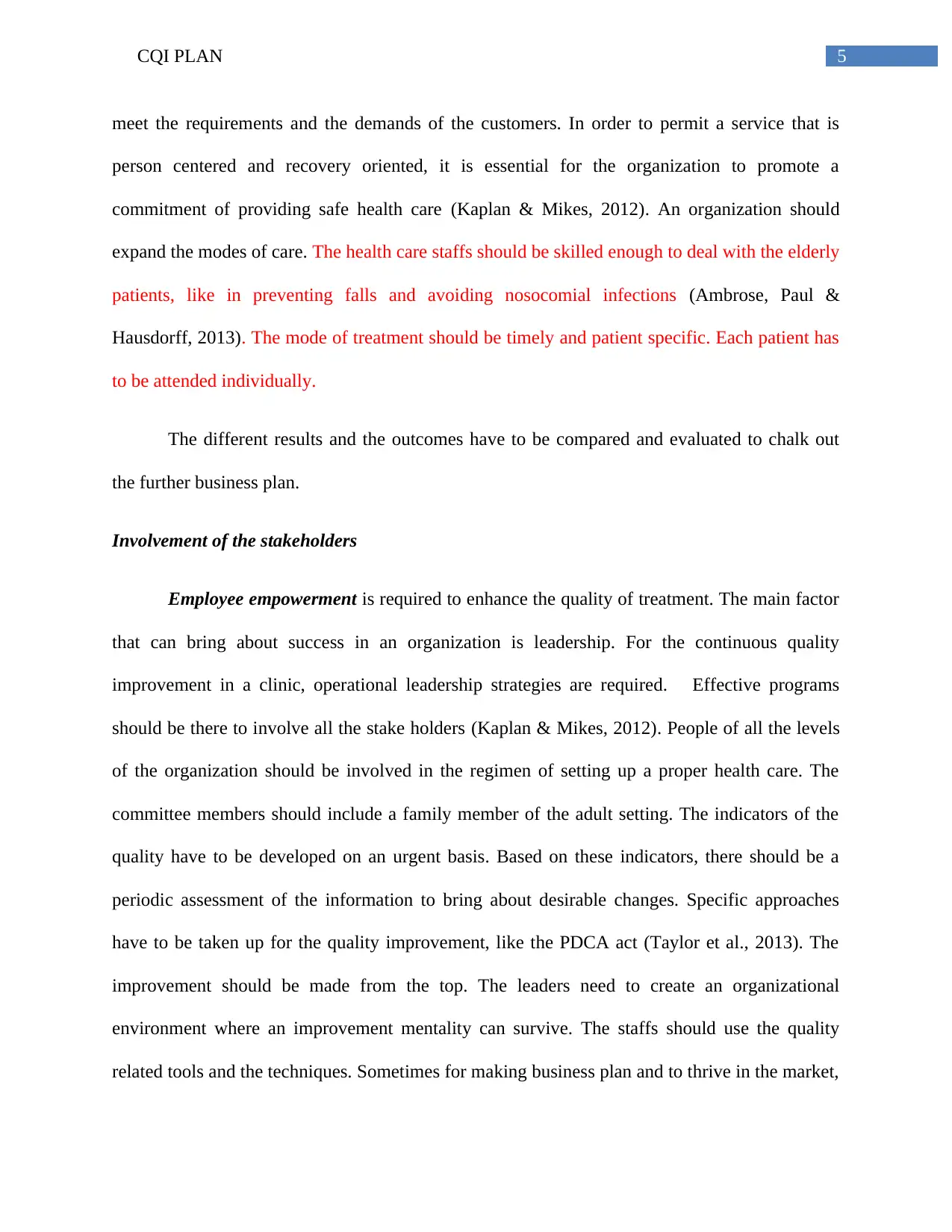
5CQI PLAN
meet the requirements and the demands of the customers. In order to permit a service that is
person centered and recovery oriented, it is essential for the organization to promote a
commitment of providing safe health care (Kaplan & Mikes, 2012). An organization should
expand the modes of care. The health care staffs should be skilled enough to deal with the elderly
patients, like in preventing falls and avoiding nosocomial infections (Ambrose, Paul &
Hausdorff, 2013). The mode of treatment should be timely and patient specific. Each patient has
to be attended individually.
The different results and the outcomes have to be compared and evaluated to chalk out
the further business plan.
Involvement of the stakeholders
Employee empowerment is required to enhance the quality of treatment. The main factor
that can bring about success in an organization is leadership. For the continuous quality
improvement in a clinic, operational leadership strategies are required. Effective programs
should be there to involve all the stake holders (Kaplan & Mikes, 2012). People of all the levels
of the organization should be involved in the regimen of setting up a proper health care. The
committee members should include a family member of the adult setting. The indicators of the
quality have to be developed on an urgent basis. Based on these indicators, there should be a
periodic assessment of the information to bring about desirable changes. Specific approaches
have to be taken up for the quality improvement, like the PDCA act (Taylor et al., 2013). The
improvement should be made from the top. The leaders need to create an organizational
environment where an improvement mentality can survive. The staffs should use the quality
related tools and the techniques. Sometimes for making business plan and to thrive in the market,
meet the requirements and the demands of the customers. In order to permit a service that is
person centered and recovery oriented, it is essential for the organization to promote a
commitment of providing safe health care (Kaplan & Mikes, 2012). An organization should
expand the modes of care. The health care staffs should be skilled enough to deal with the elderly
patients, like in preventing falls and avoiding nosocomial infections (Ambrose, Paul &
Hausdorff, 2013). The mode of treatment should be timely and patient specific. Each patient has
to be attended individually.
The different results and the outcomes have to be compared and evaluated to chalk out
the further business plan.
Involvement of the stakeholders
Employee empowerment is required to enhance the quality of treatment. The main factor
that can bring about success in an organization is leadership. For the continuous quality
improvement in a clinic, operational leadership strategies are required. Effective programs
should be there to involve all the stake holders (Kaplan & Mikes, 2012). People of all the levels
of the organization should be involved in the regimen of setting up a proper health care. The
committee members should include a family member of the adult setting. The indicators of the
quality have to be developed on an urgent basis. Based on these indicators, there should be a
periodic assessment of the information to bring about desirable changes. Specific approaches
have to be taken up for the quality improvement, like the PDCA act (Taylor et al., 2013). The
improvement should be made from the top. The leaders need to create an organizational
environment where an improvement mentality can survive. The staffs should use the quality
related tools and the techniques. Sometimes for making business plan and to thrive in the market,
⊘ This is a preview!⊘
Do you want full access?
Subscribe today to unlock all pages.

Trusted by 1+ million students worldwide
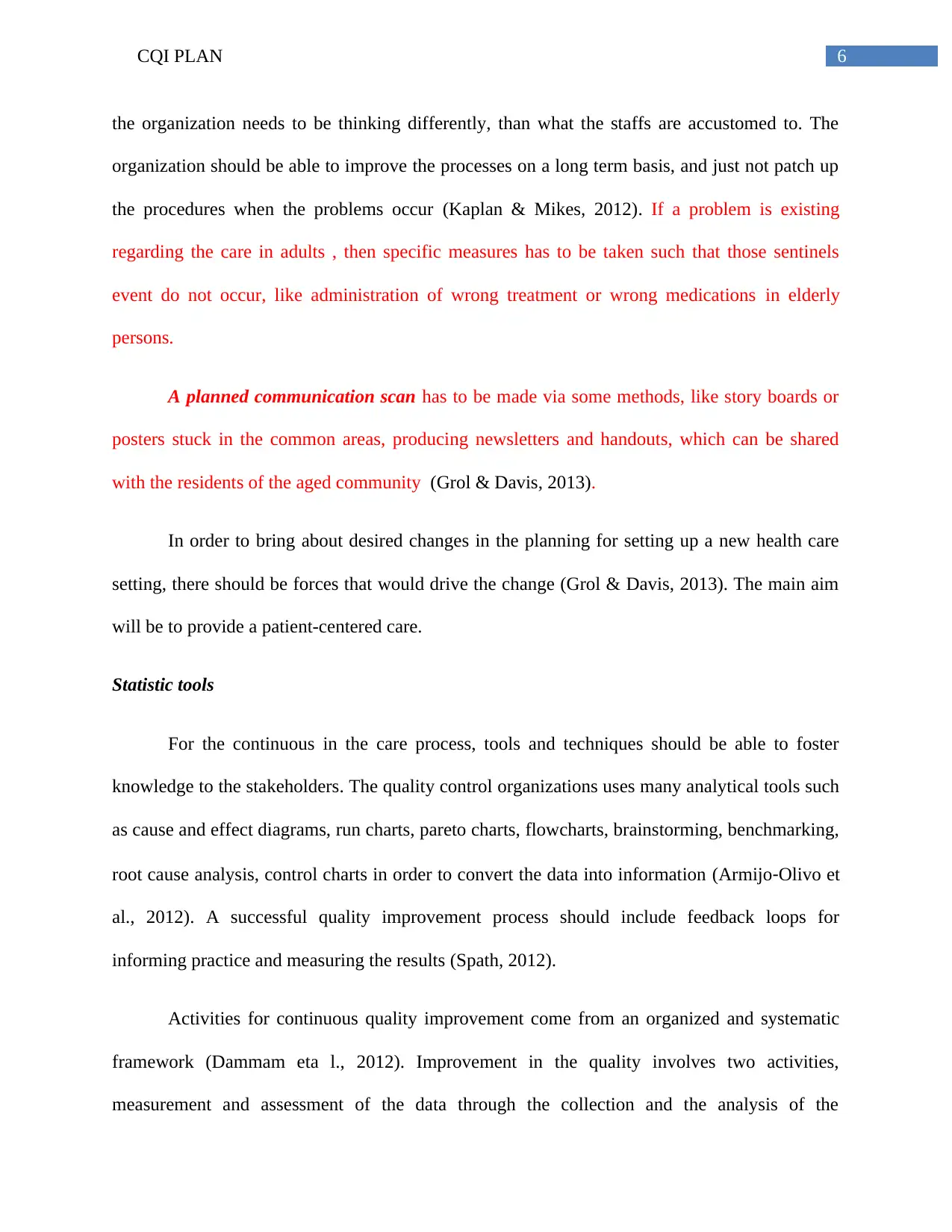
6CQI PLAN
the organization needs to be thinking differently, than what the staffs are accustomed to. The
organization should be able to improve the processes on a long term basis, and just not patch up
the procedures when the problems occur (Kaplan & Mikes, 2012). If a problem is existing
regarding the care in adults , then specific measures has to be taken such that those sentinels
event do not occur, like administration of wrong treatment or wrong medications in elderly
persons.
A planned communication scan has to be made via some methods, like story boards or
posters stuck in the common areas, producing newsletters and handouts, which can be shared
with the residents of the aged community (Grol & Davis, 2013).
In order to bring about desired changes in the planning for setting up a new health care
setting, there should be forces that would drive the change (Grol & Davis, 2013). The main aim
will be to provide a patient-centered care.
Statistic tools
For the continuous in the care process, tools and techniques should be able to foster
knowledge to the stakeholders. The quality control organizations uses many analytical tools such
as cause and effect diagrams, run charts, pareto charts, flowcharts, brainstorming, benchmarking,
root cause analysis, control charts in order to convert the data into information (Armijo‐Olivo et
al., 2012). A successful quality improvement process should include feedback loops for
informing practice and measuring the results (Spath, 2012).
Activities for continuous quality improvement come from an organized and systematic
framework (Dammam eta l., 2012). Improvement in the quality involves two activities,
measurement and assessment of the data through the collection and the analysis of the
the organization needs to be thinking differently, than what the staffs are accustomed to. The
organization should be able to improve the processes on a long term basis, and just not patch up
the procedures when the problems occur (Kaplan & Mikes, 2012). If a problem is existing
regarding the care in adults , then specific measures has to be taken such that those sentinels
event do not occur, like administration of wrong treatment or wrong medications in elderly
persons.
A planned communication scan has to be made via some methods, like story boards or
posters stuck in the common areas, producing newsletters and handouts, which can be shared
with the residents of the aged community (Grol & Davis, 2013).
In order to bring about desired changes in the planning for setting up a new health care
setting, there should be forces that would drive the change (Grol & Davis, 2013). The main aim
will be to provide a patient-centered care.
Statistic tools
For the continuous in the care process, tools and techniques should be able to foster
knowledge to the stakeholders. The quality control organizations uses many analytical tools such
as cause and effect diagrams, run charts, pareto charts, flowcharts, brainstorming, benchmarking,
root cause analysis, control charts in order to convert the data into information (Armijo‐Olivo et
al., 2012). A successful quality improvement process should include feedback loops for
informing practice and measuring the results (Spath, 2012).
Activities for continuous quality improvement come from an organized and systematic
framework (Dammam eta l., 2012). Improvement in the quality involves two activities,
measurement and assessment of the data through the collection and the analysis of the
Paraphrase This Document
Need a fresh take? Get an instant paraphrase of this document with our AI Paraphraser
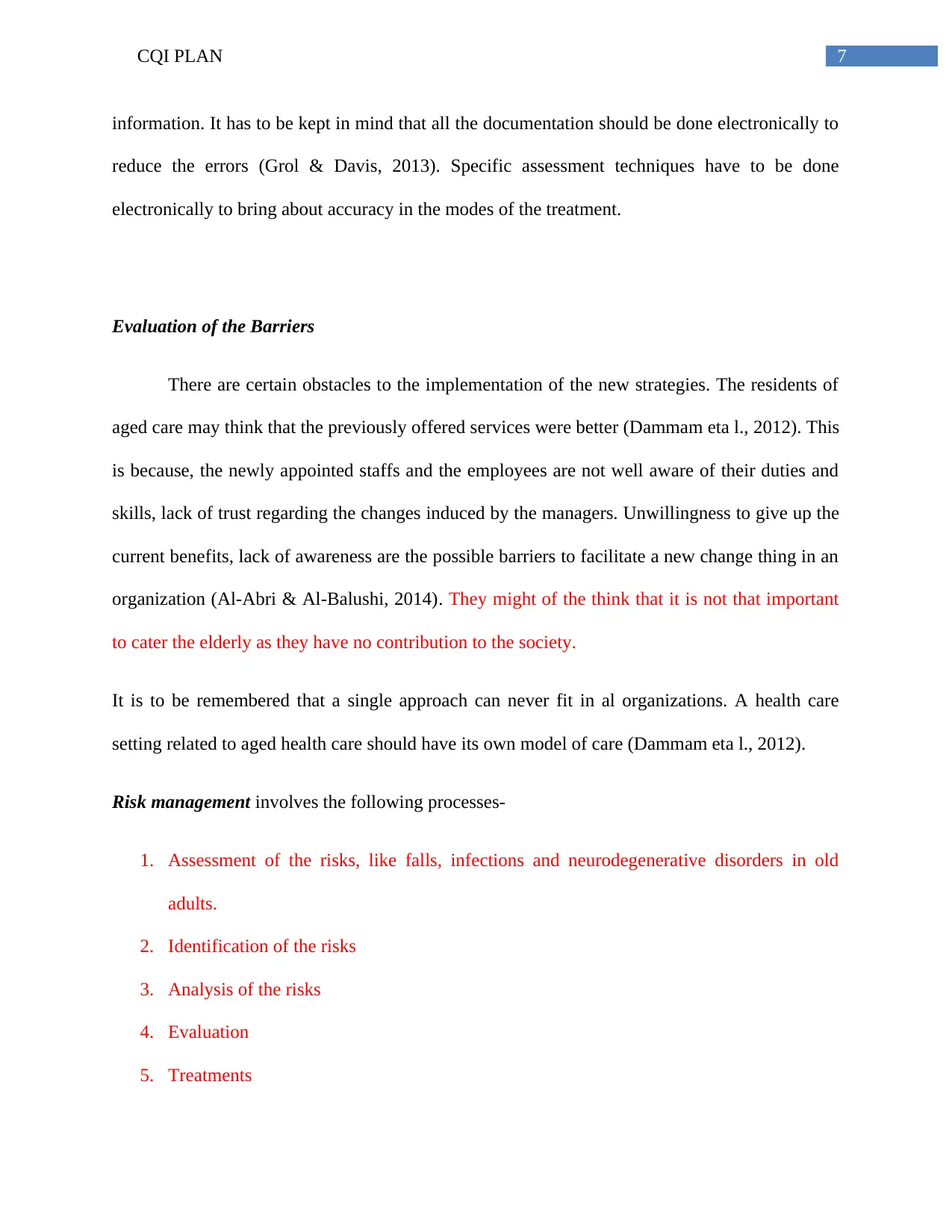
7CQI PLAN
information. It has to be kept in mind that all the documentation should be done electronically to
reduce the errors (Grol & Davis, 2013). Specific assessment techniques have to be done
electronically to bring about accuracy in the modes of the treatment.
Evaluation of the Barriers
There are certain obstacles to the implementation of the new strategies. The residents of
aged care may think that the previously offered services were better (Dammam eta l., 2012). This
is because, the newly appointed staffs and the employees are not well aware of their duties and
skills, lack of trust regarding the changes induced by the managers. Unwillingness to give up the
current benefits, lack of awareness are the possible barriers to facilitate a new change thing in an
organization (Al-Abri & Al-Balushi, 2014). They might of the think that it is not that important
to cater the elderly as they have no contribution to the society.
It is to be remembered that a single approach can never fit in al organizations. A health care
setting related to aged health care should have its own model of care (Dammam eta l., 2012).
Risk management involves the following processes-
1. Assessment of the risks, like falls, infections and neurodegenerative disorders in old
adults.
2. Identification of the risks
3. Analysis of the risks
4. Evaluation
5. Treatments
information. It has to be kept in mind that all the documentation should be done electronically to
reduce the errors (Grol & Davis, 2013). Specific assessment techniques have to be done
electronically to bring about accuracy in the modes of the treatment.
Evaluation of the Barriers
There are certain obstacles to the implementation of the new strategies. The residents of
aged care may think that the previously offered services were better (Dammam eta l., 2012). This
is because, the newly appointed staffs and the employees are not well aware of their duties and
skills, lack of trust regarding the changes induced by the managers. Unwillingness to give up the
current benefits, lack of awareness are the possible barriers to facilitate a new change thing in an
organization (Al-Abri & Al-Balushi, 2014). They might of the think that it is not that important
to cater the elderly as they have no contribution to the society.
It is to be remembered that a single approach can never fit in al organizations. A health care
setting related to aged health care should have its own model of care (Dammam eta l., 2012).
Risk management involves the following processes-
1. Assessment of the risks, like falls, infections and neurodegenerative disorders in old
adults.
2. Identification of the risks
3. Analysis of the risks
4. Evaluation
5. Treatments
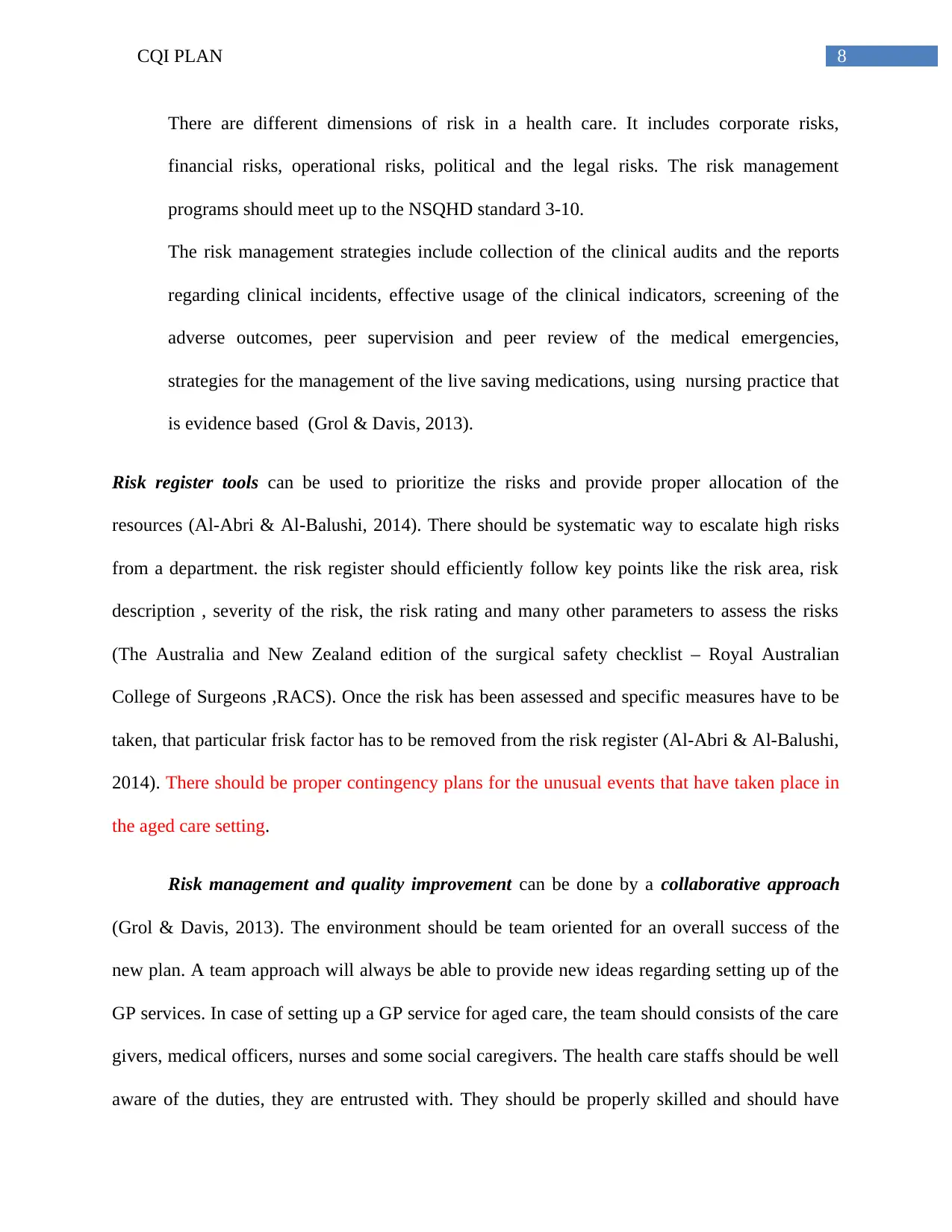
8CQI PLAN
There are different dimensions of risk in a health care. It includes corporate risks,
financial risks, operational risks, political and the legal risks. The risk management
programs should meet up to the NSQHD standard 3-10.
The risk management strategies include collection of the clinical audits and the reports
regarding clinical incidents, effective usage of the clinical indicators, screening of the
adverse outcomes, peer supervision and peer review of the medical emergencies,
strategies for the management of the live saving medications, using nursing practice that
is evidence based (Grol & Davis, 2013).
Risk register tools can be used to prioritize the risks and provide proper allocation of the
resources (Al-Abri & Al-Balushi, 2014). There should be systematic way to escalate high risks
from a department. the risk register should efficiently follow key points like the risk area, risk
description , severity of the risk, the risk rating and many other parameters to assess the risks
(The Australia and New Zealand edition of the surgical safety checklist – Royal Australian
College of Surgeons ,RACS). Once the risk has been assessed and specific measures have to be
taken, that particular frisk factor has to be removed from the risk register (Al-Abri & Al-Balushi,
2014). There should be proper contingency plans for the unusual events that have taken place in
the aged care setting.
Risk management and quality improvement can be done by a collaborative approach
(Grol & Davis, 2013). The environment should be team oriented for an overall success of the
new plan. A team approach will always be able to provide new ideas regarding setting up of the
GP services. In case of setting up a GP service for aged care, the team should consists of the care
givers, medical officers, nurses and some social caregivers. The health care staffs should be well
aware of the duties, they are entrusted with. They should be properly skilled and should have
There are different dimensions of risk in a health care. It includes corporate risks,
financial risks, operational risks, political and the legal risks. The risk management
programs should meet up to the NSQHD standard 3-10.
The risk management strategies include collection of the clinical audits and the reports
regarding clinical incidents, effective usage of the clinical indicators, screening of the
adverse outcomes, peer supervision and peer review of the medical emergencies,
strategies for the management of the live saving medications, using nursing practice that
is evidence based (Grol & Davis, 2013).
Risk register tools can be used to prioritize the risks and provide proper allocation of the
resources (Al-Abri & Al-Balushi, 2014). There should be systematic way to escalate high risks
from a department. the risk register should efficiently follow key points like the risk area, risk
description , severity of the risk, the risk rating and many other parameters to assess the risks
(The Australia and New Zealand edition of the surgical safety checklist – Royal Australian
College of Surgeons ,RACS). Once the risk has been assessed and specific measures have to be
taken, that particular frisk factor has to be removed from the risk register (Al-Abri & Al-Balushi,
2014). There should be proper contingency plans for the unusual events that have taken place in
the aged care setting.
Risk management and quality improvement can be done by a collaborative approach
(Grol & Davis, 2013). The environment should be team oriented for an overall success of the
new plan. A team approach will always be able to provide new ideas regarding setting up of the
GP services. In case of setting up a GP service for aged care, the team should consists of the care
givers, medical officers, nurses and some social caregivers. The health care staffs should be well
aware of the duties, they are entrusted with. They should be properly skilled and should have
⊘ This is a preview!⊘
Do you want full access?
Subscribe today to unlock all pages.

Trusted by 1+ million students worldwide
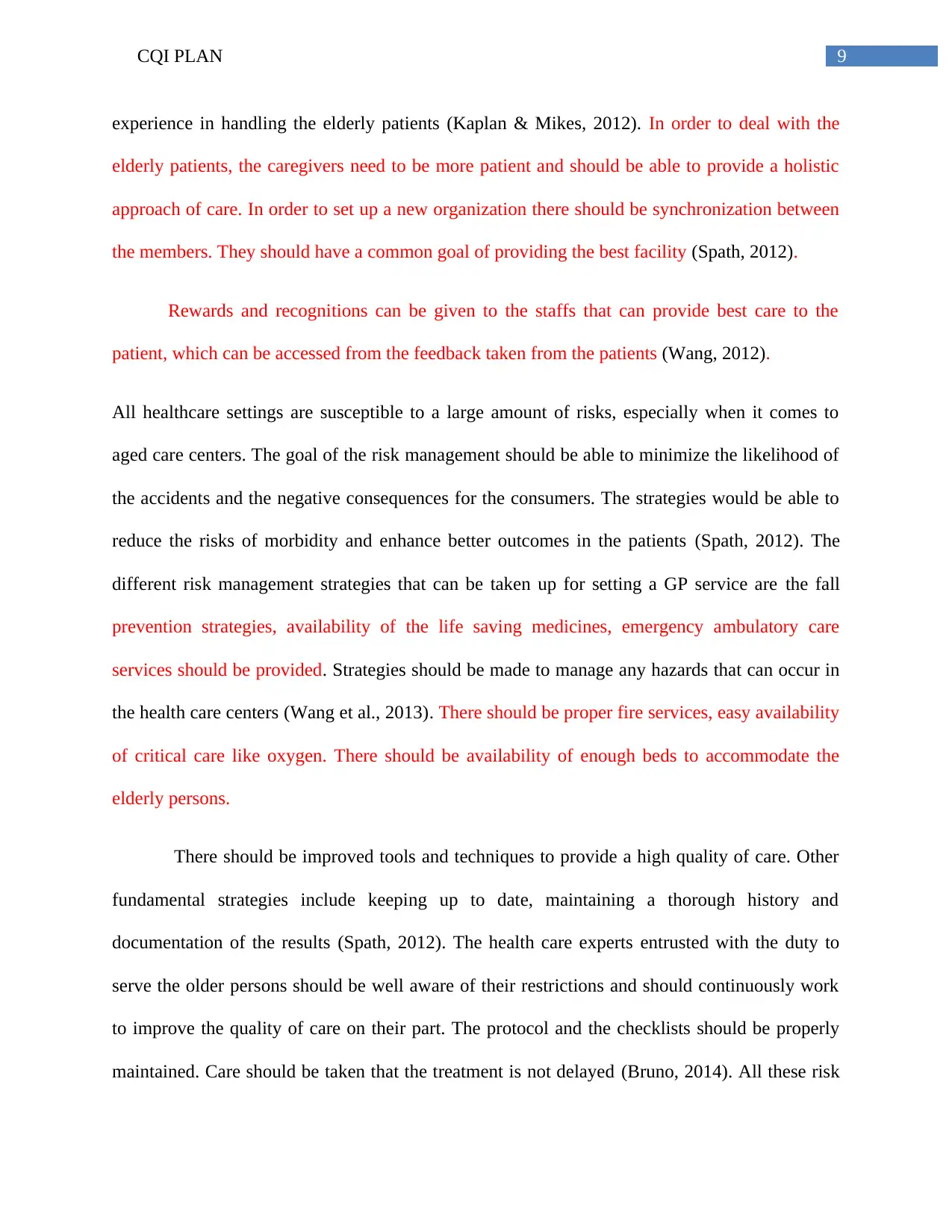
9CQI PLAN
experience in handling the elderly patients (Kaplan & Mikes, 2012). In order to deal with the
elderly patients, the caregivers need to be more patient and should be able to provide a holistic
approach of care. In order to set up a new organization there should be synchronization between
the members. They should have a common goal of providing the best facility (Spath, 2012).
Rewards and recognitions can be given to the staffs that can provide best care to the
patient, which can be accessed from the feedback taken from the patients (Wang, 2012).
All healthcare settings are susceptible to a large amount of risks, especially when it comes to
aged care centers. The goal of the risk management should be able to minimize the likelihood of
the accidents and the negative consequences for the consumers. The strategies would be able to
reduce the risks of morbidity and enhance better outcomes in the patients (Spath, 2012). The
different risk management strategies that can be taken up for setting a GP service are the fall
prevention strategies, availability of the life saving medicines, emergency ambulatory care
services should be provided. Strategies should be made to manage any hazards that can occur in
the health care centers (Wang et al., 2013). There should be proper fire services, easy availability
of critical care like oxygen. There should be availability of enough beds to accommodate the
elderly persons.
There should be improved tools and techniques to provide a high quality of care. Other
fundamental strategies include keeping up to date, maintaining a thorough history and
documentation of the results (Spath, 2012). The health care experts entrusted with the duty to
serve the older persons should be well aware of their restrictions and should continuously work
to improve the quality of care on their part. The protocol and the checklists should be properly
maintained. Care should be taken that the treatment is not delayed (Bruno, 2014). All these risk
experience in handling the elderly patients (Kaplan & Mikes, 2012). In order to deal with the
elderly patients, the caregivers need to be more patient and should be able to provide a holistic
approach of care. In order to set up a new organization there should be synchronization between
the members. They should have a common goal of providing the best facility (Spath, 2012).
Rewards and recognitions can be given to the staffs that can provide best care to the
patient, which can be accessed from the feedback taken from the patients (Wang, 2012).
All healthcare settings are susceptible to a large amount of risks, especially when it comes to
aged care centers. The goal of the risk management should be able to minimize the likelihood of
the accidents and the negative consequences for the consumers. The strategies would be able to
reduce the risks of morbidity and enhance better outcomes in the patients (Spath, 2012). The
different risk management strategies that can be taken up for setting a GP service are the fall
prevention strategies, availability of the life saving medicines, emergency ambulatory care
services should be provided. Strategies should be made to manage any hazards that can occur in
the health care centers (Wang et al., 2013). There should be proper fire services, easy availability
of critical care like oxygen. There should be availability of enough beds to accommodate the
elderly persons.
There should be improved tools and techniques to provide a high quality of care. Other
fundamental strategies include keeping up to date, maintaining a thorough history and
documentation of the results (Spath, 2012). The health care experts entrusted with the duty to
serve the older persons should be well aware of their restrictions and should continuously work
to improve the quality of care on their part. The protocol and the checklists should be properly
maintained. Care should be taken that the treatment is not delayed (Bruno, 2014). All these risk
Paraphrase This Document
Need a fresh take? Get an instant paraphrase of this document with our AI Paraphraser
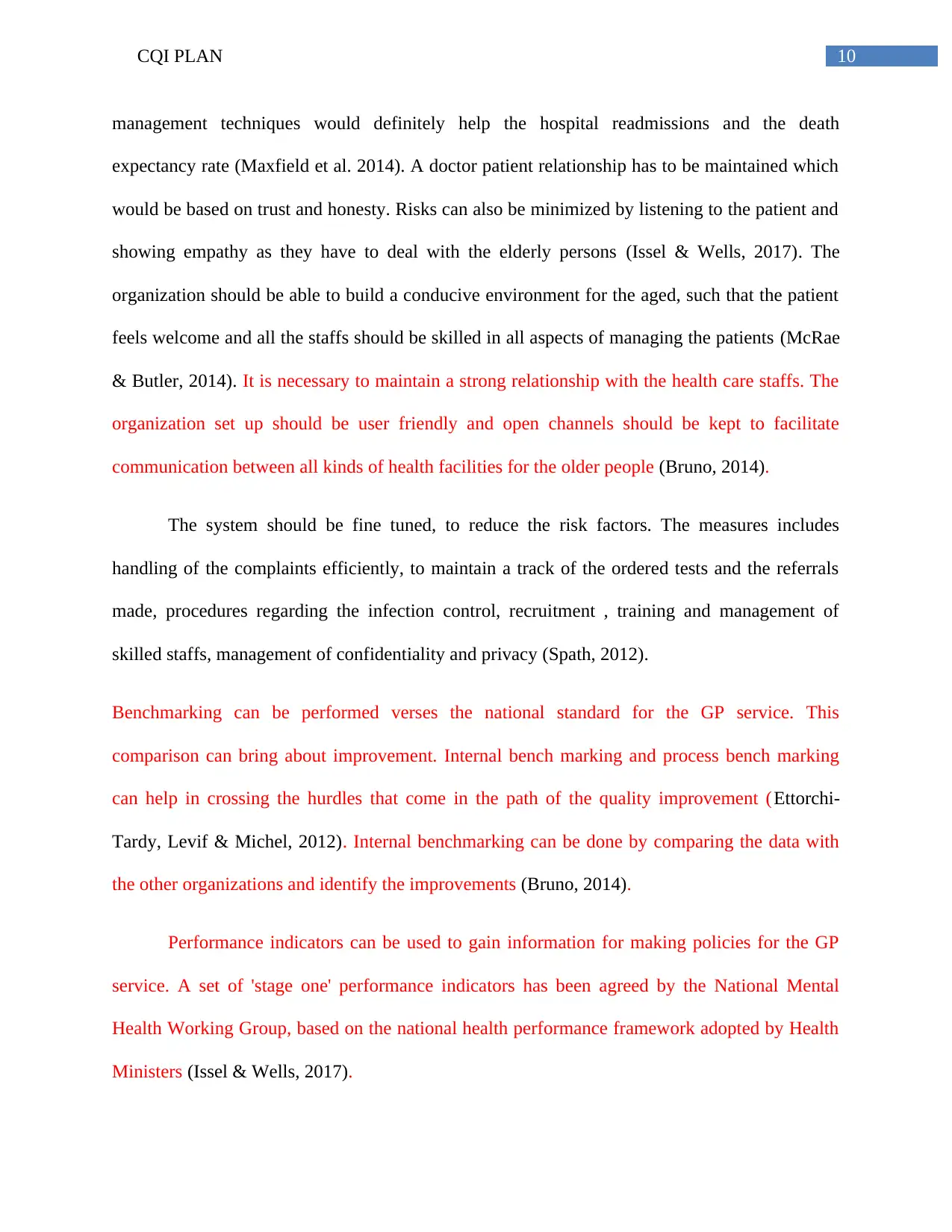
10CQI PLAN
management techniques would definitely help the hospital readmissions and the death
expectancy rate (Maxfield et al. 2014). A doctor patient relationship has to be maintained which
would be based on trust and honesty. Risks can also be minimized by listening to the patient and
showing empathy as they have to deal with the elderly persons (Issel & Wells, 2017). The
organization should be able to build a conducive environment for the aged, such that the patient
feels welcome and all the staffs should be skilled in all aspects of managing the patients (McRae
& Butler, 2014). It is necessary to maintain a strong relationship with the health care staffs. The
organization set up should be user friendly and open channels should be kept to facilitate
communication between all kinds of health facilities for the older people (Bruno, 2014).
The system should be fine tuned, to reduce the risk factors. The measures includes
handling of the complaints efficiently, to maintain a track of the ordered tests and the referrals
made, procedures regarding the infection control, recruitment , training and management of
skilled staffs, management of confidentiality and privacy (Spath, 2012).
Benchmarking can be performed verses the national standard for the GP service. This
comparison can bring about improvement. Internal bench marking and process bench marking
can help in crossing the hurdles that come in the path of the quality improvement (Ettorchi-
Tardy, Levif & Michel, 2012). Internal benchmarking can be done by comparing the data with
the other organizations and identify the improvements (Bruno, 2014).
Performance indicators can be used to gain information for making policies for the GP
service. A set of 'stage one' performance indicators has been agreed by the National Mental
Health Working Group, based on the national health performance framework adopted by Health
Ministers (Issel & Wells, 2017).
management techniques would definitely help the hospital readmissions and the death
expectancy rate (Maxfield et al. 2014). A doctor patient relationship has to be maintained which
would be based on trust and honesty. Risks can also be minimized by listening to the patient and
showing empathy as they have to deal with the elderly persons (Issel & Wells, 2017). The
organization should be able to build a conducive environment for the aged, such that the patient
feels welcome and all the staffs should be skilled in all aspects of managing the patients (McRae
& Butler, 2014). It is necessary to maintain a strong relationship with the health care staffs. The
organization set up should be user friendly and open channels should be kept to facilitate
communication between all kinds of health facilities for the older people (Bruno, 2014).
The system should be fine tuned, to reduce the risk factors. The measures includes
handling of the complaints efficiently, to maintain a track of the ordered tests and the referrals
made, procedures regarding the infection control, recruitment , training and management of
skilled staffs, management of confidentiality and privacy (Spath, 2012).
Benchmarking can be performed verses the national standard for the GP service. This
comparison can bring about improvement. Internal bench marking and process bench marking
can help in crossing the hurdles that come in the path of the quality improvement (Ettorchi-
Tardy, Levif & Michel, 2012). Internal benchmarking can be done by comparing the data with
the other organizations and identify the improvements (Bruno, 2014).
Performance indicators can be used to gain information for making policies for the GP
service. A set of 'stage one' performance indicators has been agreed by the National Mental
Health Working Group, based on the national health performance framework adopted by Health
Ministers (Issel & Wells, 2017).
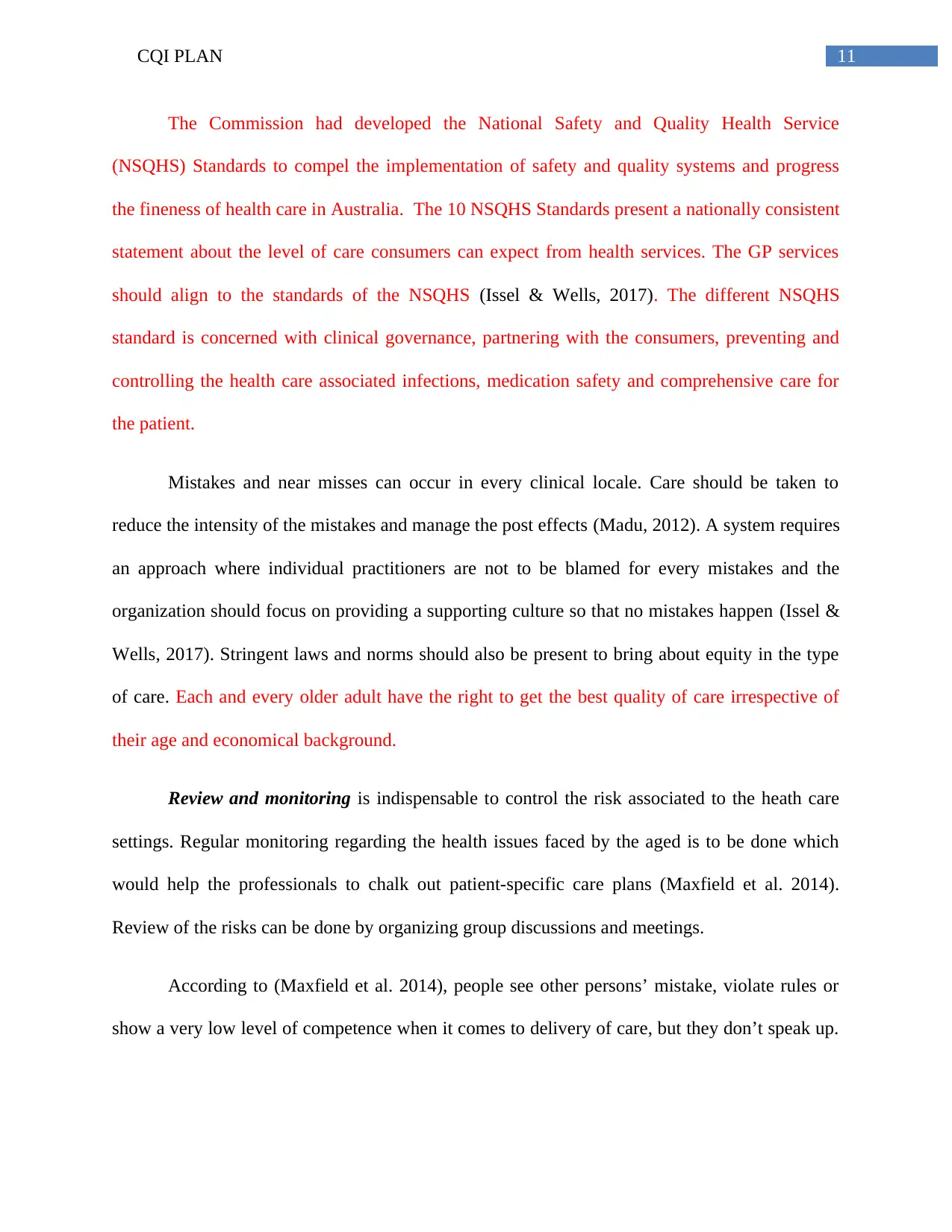
11CQI PLAN
The Commission had developed the National Safety and Quality Health Service
(NSQHS) Standards to compel the implementation of safety and quality systems and progress
the fineness of health care in Australia. The 10 NSQHS Standards present a nationally consistent
statement about the level of care consumers can expect from health services. The GP services
should align to the standards of the NSQHS (Issel & Wells, 2017). The different NSQHS
standard is concerned with clinical governance, partnering with the consumers, preventing and
controlling the health care associated infections, medication safety and comprehensive care for
the patient.
Mistakes and near misses can occur in every clinical locale. Care should be taken to
reduce the intensity of the mistakes and manage the post effects (Madu, 2012). A system requires
an approach where individual practitioners are not to be blamed for every mistakes and the
organization should focus on providing a supporting culture so that no mistakes happen (Issel &
Wells, 2017). Stringent laws and norms should also be present to bring about equity in the type
of care. Each and every older adult have the right to get the best quality of care irrespective of
their age and economical background.
Review and monitoring is indispensable to control the risk associated to the heath care
settings. Regular monitoring regarding the health issues faced by the aged is to be done which
would help the professionals to chalk out patient-specific care plans (Maxfield et al. 2014).
Review of the risks can be done by organizing group discussions and meetings.
According to (Maxfield et al. 2014), people see other persons’ mistake, violate rules or
show a very low level of competence when it comes to delivery of care, but they don’t speak up.
The Commission had developed the National Safety and Quality Health Service
(NSQHS) Standards to compel the implementation of safety and quality systems and progress
the fineness of health care in Australia. The 10 NSQHS Standards present a nationally consistent
statement about the level of care consumers can expect from health services. The GP services
should align to the standards of the NSQHS (Issel & Wells, 2017). The different NSQHS
standard is concerned with clinical governance, partnering with the consumers, preventing and
controlling the health care associated infections, medication safety and comprehensive care for
the patient.
Mistakes and near misses can occur in every clinical locale. Care should be taken to
reduce the intensity of the mistakes and manage the post effects (Madu, 2012). A system requires
an approach where individual practitioners are not to be blamed for every mistakes and the
organization should focus on providing a supporting culture so that no mistakes happen (Issel &
Wells, 2017). Stringent laws and norms should also be present to bring about equity in the type
of care. Each and every older adult have the right to get the best quality of care irrespective of
their age and economical background.
Review and monitoring is indispensable to control the risk associated to the heath care
settings. Regular monitoring regarding the health issues faced by the aged is to be done which
would help the professionals to chalk out patient-specific care plans (Maxfield et al. 2014).
Review of the risks can be done by organizing group discussions and meetings.
According to (Maxfield et al. 2014), people see other persons’ mistake, violate rules or
show a very low level of competence when it comes to delivery of care, but they don’t speak up.
⊘ This is a preview!⊘
Do you want full access?
Subscribe today to unlock all pages.

Trusted by 1+ million students worldwide
1 out of 21
Related Documents
Your All-in-One AI-Powered Toolkit for Academic Success.
+13062052269
info@desklib.com
Available 24*7 on WhatsApp / Email
![[object Object]](/_next/static/media/star-bottom.7253800d.svg)
Unlock your academic potential
Copyright © 2020–2025 A2Z Services. All Rights Reserved. Developed and managed by ZUCOL.





